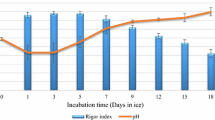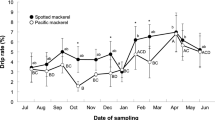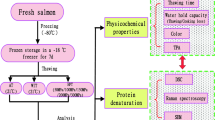Abstract
In the current study, two different slaughtering procedures, spiking vs immersion in water/ice slurry, were applied on electrically stunned European sea bass (Dicentrarchus labrax) and the effects on actin degradation and fillet quality attributes were investigated. Rigor mortis index was similar for the two slaughtering techniques, whereas the shear force measurement indicated that rigor mortis occurred more quickly and intensely in the water/ice handled fish than in those slaughtered by spiking. The water/ice immersion procedure also resulted in higher amount of actin fragments than spiking. Muscle tissue apparent viscosity and water holding capacity were lower in sea bass treated in water/ice slurry compared with fish handled by spiking, whereas the acidification patterns of the two groups were not easily distinguishable. In conclusion, spiking appeared to preserve actin integrity better that water/ice and it seemed to ensure less muscle damage as indicated by the higher viscosity and water holding capacity values. Finally, a role of actin as a biochemical marker for the prediction of fish quality was suggested.







Similar content being viewed by others
References
Ashley PJ (2007) Fish welfare: current issues in aquaculture. Appl Anim Behav Sci 104:199–235. doi:10.1016/j.applanim.2006.09.001
Aursand IG, Erikson U, Veliyulin E (2010) Water properties and salt uptake in Atlantic salmon fillets as affected by ante-mortem stress, rigor mortis, and brine salting: a low-field 1H NMR and 1H/23Na MRI study. Food Chem 120:482–489. doi:10.1016/j.foodchem.2009.10.041
Azam K, Mackie IM, Smith J (1990) Effect of stunning methods on the time of onset, duration and resolution of rigor in rainbow trout (Salmo gardineri) as measured by visual observation and analysis for lactic acid, nucleotide-degradation products and glycogen. In: Proceedings of the Meeting of Commission C2. I.I.F.-I.I.R., Aberdeen, pp 351–358
Becila S, Herrera-Mendez CH, Coulis G, Labas R, Astruc T, Picard B, Boudjellal A, Pelissier P, Bremaud L, Ouali A (2010) Postmortem muscle cells die through apoptosis. Eur Food Res Technol 231:485–493. doi:10.1007/s00217-010-1296-5
Bito M, Yamada K, Mikumo Y, Amano K (1983) Studies on rigor mortis of fish. 1 differences in the mode of rigor mortis among some varieties of fish by modified Cutting’s method. Bull Tokai Reg Fish Res Lab 109:89–96
Borderías AJ, Sánchez-Alonso I (2011) First processing steps and the quality of wild and farmed fish. J Food Sci 76:R1–R5. doi:10.1111/j.1750-3841.2010.01900.x
Borderias A, Jimenez-Colmenero F, Tejada M (1985) Parameters affecting viscosity as a quality control for frozen fish. Mar Fish Rev 47:43–45
Bouton PE, Harris PV, Shorthouse WR (1975) Changes in shear parameters of meat associated with structural changes produced by aging, cooking and myofbrillar contraction. J Food Sci 40:1122–1126. doi:10.1111/j.1365-2621.1975.tb01032.x
Conte F (2004) Stress and the welfare of cultured fish. Appl Anim Behav Sci 86:205–223. doi:10.1016/j.applanim.2004.02.003
Delbarre-Ladrat C, Chéret R, Taylor R, Verrez-Bagnis V (2006) Trends in postmortem aging in fish: understanding of proteolysis and disorganization of the myofibrillar structure. Crit Rev Food Sci Nutr 46:409–421. doi:10.1080/10408390591000929
EU Directive 2010/63/EU of the European Parliament and of the Council of 22 September 2010 on the protection of animals used for scientific purposes (2010) Off J Eur Union 20.10.2010
EFSA (2012) Species-specific welfare aspects of the main systems of stunning and killing of farmed sea bass and seabream-scientific opinion of the panel on animal health and welfare. EFSA J 9:1–52
FAO (1973) The state of food and agriculture. FAO, Roma, Italy, 216 pp
FAO (2001) Fishing with traps and pots. FAO, Roma, Italy
Feng Y, Hultin HO (2001) Effect of pH on the rheological and structural properties of gels of water-washed chicken-breast muscle at physiological ionic strength. J Agric Food Chem 49:3927–3935. doi:10.1021/jf001021f
Fuentes A, Fernández-Segovia I, Serra JA, Barat JM (2010) Comparison of wild and cultured sea bass (Dicentrarchus labrax) quality. Food Chem 119:1514–1518. doi:10.1016/j.foodchem.2009.09.036
Hultmann L, Phu TM, Tobiassen T, Aas-Hansen Ø, Rustad T (2012) Effects of pre-slaughter stress on proteolytic enzyme activities and muscle quality of farmed Atlantic cod (Gadus morhua). Food Chem 134:1399–1408. doi:10.1016/j.foodchem.2012.03.038
Huntingford F, Adams C, Braithwaite V, Kadri S, Pottinger T, Sandoe P, Turnbull J (2006) Current issues in fish welfare. J Fish Biol 68:332–372. doi:10.1111/j.0022-1112.2006.001046.x
Kee AJ, Gunning PW, Hardeman EC (2009) Diverse roles of the actin cytoskeleton in striated muscle. J Muscle Res Cell Motil 30:187–197. doi:10.1007/s10974-009-9193-x
Laemmli U (1970) Cleavage of structural proteins during the assembly of the head of bacteriophage T4. Nature 227:680–685
Lines JA, Spence J (2014) Humane harvesting and slaughter of farmed fish. Rev Sci Tech Off Int Epiz 33:255–264
Liu Q, Bao H, Xi C, Miao H (2014) Rheological characterization of tuna myofibrillar protein in linear and nonlinear viscoelastic regions. J Food Eng 121:58–63. doi:10.1016/j.jfoodeng.2013.08.016
Martinez I, Wang PA, Slizyté R, Jorge A, Dahle SW, Cañas B, Yamashita M, Olsen RL, Erikson U (2011) Protein expression and enzymatic activities in normal and soft textured Atlantic salmon (Salmo salar) muscle. Food Chem 126:140–148. doi:10.1016/j.foodchem.2010.10.090
Merkin GV, Stien LH, Pittman K, Nortvedt R (2014) The effect of stunning methods and season on muscle texture hardness in Atlantic Salmon (Salmo salar L.). J Food Sci 79:E1137–E1141. doi:10.1111/1750-3841.12473
Olsson GB, Ofstad R, Lødemel JB, Olsen RL (2003) Changes in water-holding capacity of halibut muscle during cold storage. LWT Food Sci Technol 36:771–778. doi:10.1016/S0023-6438(03)00098-7
Ouali A, Gagaoua M, Boudida Y, Becil S, Boudjellal A, Herrera-Mendez CH, Sentandreu M (2013) Biomarkers of meat tenderness: present knowledge and perspectives in regards to our current understanding of the mechanisms involved. Meat Sci 95:854–870. doi:10.1016/j.meatsci.2013.05.010
Piñeiro C, Barros-Velazquez J, Perez-Martin RI, Martinez I, Jacobsen T, Rehbein H, Kudinger R, Mendes R, Etienne M, Jerome M, Craig A, Mackie IM, Jessen F (1999) Development of a sodium dodecyl sulfate‐polyacrylamide gel electrophoresis reference method for the analysis and identification of fish species in raw and heat‐processed samples. Electrophoresis 20:1425–1432. doi:10.1002/(SICI)1522-2683(19990601)20:7<1425::AID-ELPS1425>3.0.CO;2-R
Poli BM, Parisi G, Scappini F, Zampacavallo G (2005) Fish welfare and quality as affected by pre-slaughter and slaughter management. Aquac Int 13:29–49. doi:10.1007/s10499-004-9035-1
Proctor M, Ryan I, McLoughlin J (1992) The effects of stunning and slaughter methods on changes in skeletal muscle and quality of farmed fish. In: Proceedings from TO. International Conference and Utilization of Fishery Products, The Nederland’s
Rubenstein P (1990) The functional importance of multiple actin isoforms. BioEssays 12:309–315
Scapigliati G, Buonocore F, Bird S, Zou J, Pelegrin P, Falasca C, Prugnoli D, Secombes CJ (2001) Phylogeny of cytokines: molecular cloning and expression analysis of sea bass Dicentrarchus labrax interleukin-1beta. Fish Shellfish Immunol 11:711–726. doi:10.1016/0309-1740(77)90025-0
Sebastio P, Ambroggi F, Baldrati G (1996) Influenza del sistema di sacrificazione su trote iridee di allevamento. I considerazioni biochimiche. Ind Conserv 71:37–49
Sosna J, Voigt S, Mathieu S, Kabelitz D, Trad A, Janssen O, Meyer-Schwesinger C, Schütze S, Adam D (2013) The proteases HtrA2/Omi and UCH-L1 regulate TNF-induced necroptosis. Cell Commun Signal 11:76. doi:10.1186/1478-811X-11-76
Utsumi T, Sakurai N, Nakano K, Ishisaka R (2003) C-Terminal 15 kDa fragment of cytoskeletal actin is posttranslationally N-myristoylatyed upon caspase-mediated cleavage and targeted to mitochondria. FEBS Lett 539:37–44. doi:10.1016/S0014-5793(03)00180-7
Verrez-Bagnis V, Ladrat C, Morzel M, Noël J, Fleurence J (2001) Protein changes in post mortem sea bass (Dicentrarchus labrax) muscle monitored by one- and two-dimensional gel electrophoresis. Electrophoresis 22:1539–1544. doi:10.1002/1522-2683(200105)22:8<1539::AID-ELPS1539>3.0.CO;2-K
Wang D, Tang J, Correia LR (2000) Salt diffusivities and salt diffusion in farmed Atlantic salmon muscle as influenced by rigor mortis. J Food Eng 43:115–123. doi:10.1016/S0260-8774(99)00140-5
Yamauchi S, Hou YY, Guo AK, Hirata H, Nakajima W, Yip AK, Yu C, Harada I, Chiam K-H, Sawada Y, Tanaka N, Kawauchi K (2014) P53-mediated activation of the mitochondrial protease HtrA2/Omi prevents cell invasion. J Cell Biol 204:1191–1207. doi:10.1083/jcb.201309107
Author information
Authors and Affiliations
Corresponding author
Additional information
Highlights
• Sea bass quality attributes resulted sensitive to slaughtering method
• Water/ice slaughtering increased the intensity of actin proteolysis compared to spiking
• Actin is proposed as a sensitive and reliable predictor of sea bass quality.
Rights and permissions
About this article
Cite this article
Tulli, F., Fabbro, A., D’Agaro, E. et al. The effect of slaughtering methods on actin degradation and on muscle quality attributes of farmed European sea bass (Dicentrarchus labrax). J Food Sci Technol 52, 7182–7190 (2015). https://doi.org/10.1007/s13197-015-1829-9
Revised:
Accepted:
Published:
Issue Date:
DOI: https://doi.org/10.1007/s13197-015-1829-9




